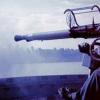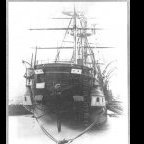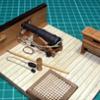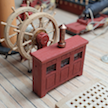
Roger Pellett
-
Posts
4,519 -
Joined
-
Last visited
Reputation Activity
-
 Roger Pellett got a reaction from mtaylor in Masts and the use of power tools
Roger Pellett got a reaction from mtaylor in Masts and the use of power tools
An easy way to make straight tapered masts. This assumes that you have table saw.
1. Rig up a simple taper jig. This is nothing more than a strip of wood that fits into the saw’s miter gauge slot fastened to a board.
2. Tack glue a mast blank to the jig so that it passes through the blade with the correct taper. Rip the blank. Rotate the blank 90 degrees, glue to the jig and rip again. You now have a tapered mast blank.
3. A second jig: two pieces of wood with one edge of each chamfered. Fasten the boards together edge to edge with the chamfers forming a Vee groove.
4. Lay the tapered blank in the Vee groove and plane each corner the same number of strokes.
5. Clamp an electric drill in a vice, chuck the mast blank and turn on the drill at slow speed. Carefully sand the octagonal plank round.
It’s easier than it sounds.
Roger
-
 Roger Pellett got a reaction from Canute in Liberty ships split rudder
Roger Pellett got a reaction from Canute in Liberty ships split rudder
Kevin,
That’s called a ContraGuide rudder. It is shaped that way to straighten flow from the propeller.
The propeller works by accelerating a column of water behind the ship. The reaction to this column of water, Newton’s Third Law, is a force in the opposite direction that pushes the ship ahead. Water, however, is viscous and this viscosity causes the water in the column from the propeller to rotate. This rotation is lost energy. The offsets on the rudder are intended to introduce a vector opposite to that of the rotating water column, to recover the lost energy.
Roger
-
 Roger Pellett reacted to LJP in Thistle 1894 by LJP – FINISHED - 1:64 scale – a Wisconsin sternwheeler by Lawrence Paplham
Roger Pellett reacted to LJP in Thistle 1894 by LJP – FINISHED - 1:64 scale – a Wisconsin sternwheeler by Lawrence Paplham
I have finally completed the two poppit engines. They are about an inch long each.
The left engine is fully open so the arm on the sternwheel will be at 3 or 9 o'clock. The right engine is fully closed so it will be at 6 or 12 o'clock.
I used photos from steamboats.com, The Machinery of Western River Steamboats by Colliery Engineer Company (circa 1900), a photo of a Mason engine and Marine Iron Works of Chicago as a guide. The result is an amalgam engine rather than a duplication of any. As Bates noted, the study of engines is a study onto itself.
I used Evergreen styrene, Plastruct ABS and some small wire in the construction. Herein lies a tale of why it took so long. Part of the time was simply making something that looked correct in scale and detail. The bigger part was finally finding a glue or solvent to use. The final solvent is Pastruct Plastic Weld which seems to be methyl-ethyl-ketone (MEK). That MEK quickly melts the plastic to create the bond. A little goes a long way and is not forgiving in either time or placement. Before that, I made several models that literally would fall apart. I now have a debris filed littered with those unsuccessful attempts.
I am now moving on to the boiler and auxiliary feed pumps. I trust that will not take as long as the engines did.
-
 Roger Pellett got a reaction from jud in Liberty ships split rudder
Roger Pellett got a reaction from jud in Liberty ships split rudder
Kevin,
That’s called a ContraGuide rudder. It is shaped that way to straighten flow from the propeller.
The propeller works by accelerating a column of water behind the ship. The reaction to this column of water, Newton’s Third Law, is a force in the opposite direction that pushes the ship ahead. Water, however, is viscous and this viscosity causes the water in the column from the propeller to rotate. This rotation is lost energy. The offsets on the rudder are intended to introduce a vector opposite to that of the rotating water column, to recover the lost energy.
Roger
-
 Roger Pellett got a reaction from SaltyNinja in Woodshop/Woodcraft Books
Roger Pellett got a reaction from SaltyNinja in Woodshop/Woodcraft Books
If you have room for them, my advice would be to outfit yourself with full sized woodworking tools, both hand and power and learn how to use them. You can then move into small modelmaking tools as the need arises.
The one skill that you need to master is keeping your edged tools sharp. Find a good book on sharpening and read it. When I have a chance later today I’ll post information on an excellent book on the subject.
Roger
-
 Roger Pellett got a reaction from Keith Black in Posting Shop Notes Questions
Roger Pellett got a reaction from Keith Black in Posting Shop Notes Questions
I don’t believe that it is exaggerating to say that MSW is the World’s finest storehouse of information about researching and constructing quality ship models. Unfortunately many questions are so indefinite that they fail to take advantage of this expertise.
For example, a question like “I am building XYZ, what glue should I use?” Is to indefinite for an intelligent response. What is the specific application, what materials are you joining, and where do you live? The answer all depends on the answer to these questions. If you are building the model in Europe, glues available at a US Big Box store may not be available where you live.
Other questions require some knowledge of your work environment. Are you building the model in an apartment? Do you have access to major woodworking or metalworking tools. For example, if your model is finished, you are building a case and you live in apartment, an answer explaining how to build a wood framed case using a table saw is probably not helpful.
In short, more specific questions will generate better answers.
Roger
-
 Roger Pellett got a reaction from BANYAN in AMAPÁ 1907 by Ras Ambrioso - FINISHED - scale 1:64 - Brazilian Customs Cruiser
Roger Pellett got a reaction from BANYAN in AMAPÁ 1907 by Ras Ambrioso - FINISHED - scale 1:64 - Brazilian Customs Cruiser
Patience and Perseverance: it’s nice to have both, but if you don’t have patience, you better have perseverance!
Roger
-
 Roger Pellett got a reaction from Canute in Woodshop/Woodcraft Books
Roger Pellett got a reaction from Canute in Woodshop/Woodcraft Books
If you have room for them, my advice would be to outfit yourself with full sized woodworking tools, both hand and power and learn how to use them. You can then move into small modelmaking tools as the need arises.
The one skill that you need to master is keeping your edged tools sharp. Find a good book on sharpening and read it. When I have a chance later today I’ll post information on an excellent book on the subject.
Roger
-

-
 Roger Pellett got a reaction from Bob Cleek in Woodshop/Woodcraft Books
Roger Pellett got a reaction from Bob Cleek in Woodshop/Woodcraft Books
If you have room for them, my advice would be to outfit yourself with full sized woodworking tools, both hand and power and learn how to use them. You can then move into small modelmaking tools as the need arises.
The one skill that you need to master is keeping your edged tools sharp. Find a good book on sharpening and read it. When I have a chance later today I’ll post information on an excellent book on the subject.
Roger
-
 Roger Pellett got a reaction from Dick Fetter in Pauline by pwog - FINISHED - BlueJacket Shipcrafters - 3/16" - Sardine Carrier
Roger Pellett got a reaction from Dick Fetter in Pauline by pwog - FINISHED - BlueJacket Shipcrafters - 3/16" - Sardine Carrier
Paul,
You’re model is shaping up to be a beauty!
Roger
-

-
 Roger Pellett got a reaction from Cathead in Flying Fish by gak1965 - FINISHED - Model Shipways - 1:96
Roger Pellett got a reaction from Cathead in Flying Fish by gak1965 - FINISHED - Model Shipways - 1:96
Jared,
A suggestion for your open boats- Use The Kit supplied cast boat as a form and vacuum form a new one. Vacuum forming is easily done with ordinary household stuff. A shop vacuum or even a canister type household vacuum provides the vacuum. At 1:96 scale, 1in planking is only about .01in thick so the thickness of the shell of the kit supplied boat is way over scale.
Roger
-
 Roger Pellett reacted to Gregory in Old Montgomery Ward Model Kit worth building?
Roger Pellett reacted to Gregory in Old Montgomery Ward Model Kit worth building?
That's never stopped anyone before..😄
-
 Roger Pellett got a reaction from Ryland Craze in Old Montgomery Ward Model Kit worth building?
Roger Pellett got a reaction from Ryland Craze in Old Montgomery Ward Model Kit worth building?
It depends on what you want to accomplish. From the drawings, it is not going to result in anything that resembles a real ship.
-
 Roger Pellett got a reaction from allanyed in Old Montgomery Ward Model Kit worth building?
Roger Pellett got a reaction from allanyed in Old Montgomery Ward Model Kit worth building?
It depends on what you want to accomplish. From the drawings, it is not going to result in anything that resembles a real ship.
-
 Roger Pellett got a reaction from mtaylor in Old Montgomery Ward Model Kit worth building?
Roger Pellett got a reaction from mtaylor in Old Montgomery Ward Model Kit worth building?
It depends on what you want to accomplish. From the drawings, it is not going to result in anything that resembles a real ship.
-
 Roger Pellett got a reaction from mbp521 in Flying Fish by gak1965 - FINISHED - Model Shipways - 1:96
Roger Pellett got a reaction from mbp521 in Flying Fish by gak1965 - FINISHED - Model Shipways - 1:96
Jared,
A suggestion for your open boats- Use The Kit supplied cast boat as a form and vacuum form a new one. Vacuum forming is easily done with ordinary household stuff. A shop vacuum or even a canister type household vacuum provides the vacuum. At 1:96 scale, 1in planking is only about .01in thick so the thickness of the shell of the kit supplied boat is way over scale.
Roger
-
 Roger Pellett got a reaction from Canute in Old Montgomery Ward Model Kit worth building?
Roger Pellett got a reaction from Canute in Old Montgomery Ward Model Kit worth building?
It depends on what you want to accomplish. From the drawings, it is not going to result in anything that resembles a real ship.
-
 Roger Pellett got a reaction from Gregory in Old Montgomery Ward Model Kit worth building?
Roger Pellett got a reaction from Gregory in Old Montgomery Ward Model Kit worth building?
It depends on what you want to accomplish. From the drawings, it is not going to result in anything that resembles a real ship.
-
 Roger Pellett reacted to bridgman in Early American windlass
Roger Pellett reacted to bridgman in Early American windlass
Rodger:
An interesting thought, considering the seriousness that some individuals put on the cup races eliminating a windless
would have been considered. The photos I have show large crews on board while she is under sail, some show a dinghy on
board, and others with an anchor on the forward port side rail. Cannot correlate photos dates to actual race dates. The few drawings
I have show outlines of some type of windlass, not much bigger than the centerboard winch, hence the search for fore deck details.
Nice article on the Puritan in Novembers Woodenboat magazine, may have to try contacting the author.
Bob
-
 Roger Pellett got a reaction from robdurant in Posting Shop Notes Questions
Roger Pellett got a reaction from robdurant in Posting Shop Notes Questions
I don’t believe that it is exaggerating to say that MSW is the World’s finest storehouse of information about researching and constructing quality ship models. Unfortunately many questions are so indefinite that they fail to take advantage of this expertise.
For example, a question like “I am building XYZ, what glue should I use?” Is to indefinite for an intelligent response. What is the specific application, what materials are you joining, and where do you live? The answer all depends on the answer to these questions. If you are building the model in Europe, glues available at a US Big Box store may not be available where you live.
Other questions require some knowledge of your work environment. Are you building the model in an apartment? Do you have access to major woodworking or metalworking tools. For example, if your model is finished, you are building a case and you live in apartment, an answer explaining how to build a wood framed case using a table saw is probably not helpful.
In short, more specific questions will generate better answers.
Roger
-
 Roger Pellett got a reaction from EricWilliamMarshall in Referance Library (Modeling)
Roger Pellett got a reaction from EricWilliamMarshall in Referance Library (Modeling)
As far as I am concerned the two are apples and oranges, and I have both. The shop notes are predominately technique. In my personal experience, once I have studied them I have "gotten the idea" and seldom refer to them.
On the other hand, the CD's contain a record of several decades of modeling research, so you might think of them as project oriented and in my opinion the articles of 30-40 years ago are much more detailed than those in the recent journals. Eric Ronnberg's multipart series of the Boston Pilot Boat Hesper and Rob Napier's articles of the mid 19th Century sailing ship Sooloo come to mind.
If you will be satisfied assembling kits, you probably don't need the CDs but if you want to take this avocation further buy them.
Re; the lack of a disc drive When I needed a new laptop, I made sure that it had a CD drive.
Roger
-
 Roger Pellett got a reaction from EricWilliamMarshall in Referance Library (Modeling)
Roger Pellett got a reaction from EricWilliamMarshall in Referance Library (Modeling)
The NRJ back issues from the 1980's and 1990's contain some excellent articles written by such world class ship model builders as Harold Hahn, Eric Ronnberg, and Rob Napier. Not only do they include modeling tips but also demonstrate the research required to produce a first class model. The two disc CD is well worth the cost which I recall being about $40.
Roger
-
 Roger Pellett got a reaction from EricWilliamMarshall in New Book by MSW Member
Roger Pellett got a reaction from EricWilliamMarshall in New Book by MSW Member
I am pleased to announce the publication today by Wayne State University Press of my first ( and last) book, Whaleback Ships and the American Steel Barge Company. As the title suggests this is a comprehensive history of the design and construction of the 44 whaleback barges and steamships. The book is based on original design drawings, company records, and extensive examination of SS Meteor, the only surviving example of a whaleback ship. Copies are available from the Press, Barnes and Noble and Amazon.
Roger










.thumb.jpeg.fc5d633a7b34428fcf19419a73d56d55.jpeg)